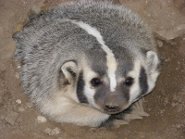 The American Badger (Taxidea taxus), is mainly found in North America's Great Plains area. They also occur in Canada's central western parts, all over the Western United States, and in the mountainous regions of Mexico. Their range in the last century has been extended to Far East of Canada and Ontario. American badgers prefer to stay in open grasslands, pastures, and dry fields.
The American Badger (Taxidea taxus), is mainly found in North America's Great Plains area. They also occur in Canada's central western parts, all over the Western United States, and in the mountainous regions of Mexico. Their range in the last century has been extended to Far East of Canada and Ontario. American badgers prefer to stay in open grasslands, pastures, and dry fields.A mature badger weighs up to 8.8 - 26.4 lbs (4-12 kg). Their total length from head to tail is about 20.5 - 34.5 inches (52 -88 cm). They have short legs and a flattened head. The color of the coat is grayish or reddish with a buffy colored ventrum. There are black patches on their face and the chin and the throat are whitish. Males are considerably larger than their counterparts and the badgers found in the north are larger than those found in the south.
American badgers breed only once a year. The main season for breeding is early autumn or late summer. There are 1-5 babies in each litter. The gestation period lasts for 6 weeks. The babies are weaned out in about 2-3 months. They become independent when they are 5-6 months old. At the time of birth, the baby weighs around 3.92 oz (93 gram). The female reaches her reproductive maturity at the age of 12 months and sometimes, even at 4 months.
American badgers are born blind and have thin fur on the skin. They open their eyes when they are 4-6 weeks old and the mother nurses them till they are 2-3 months old. The offspring come out of their den early (within 5-6 weeks) and disperse when they reach 5-6 months. Life expectancy of American badgers is about 14 years in the wild and in captivity they can survive up to 26 years.
Badgers are mainly solitary animals. There are generally only five to six badgers per square km. They are most active at night, but during winters, they are not that active. Although, not truly hibernators, much of their time in winters passes in torpor. In winters, they come out from their dens only on warm days.
One can call American Badgers brilliant digging machines. Their forelimbs are quite powerful to help them dig the soil rapidly. They construct burrows in search of their prey but apart from this, these burrows also serve the purpose of sleeping. They dig up to three meters in the soil.
Badgers are mainly carnivorous animals. They have an extremely big range as far as food is concerned. They prey on ground squirrels, pocket gophers, marmots, moles, voles, deer mice, lizards, wood rats, fish, nesting birds, amphibians, insects etc. They do not prey on open grounds and most of their food requirement comes from digging.
Golden eagles, humans, Coyotes, bobcats, and cougars are their main predators. By hunting, trapping, poisoning, and automobile fatalities, the primary predators, humans have become responsible for the destruction of their habitat.
Picture of the American badger by Jonathunder, licensed under Creative Commons Attribution ShareAlike 3.0
The American badger is listed as Least Concern (LR/lc), lowest risk. Does not qualify for a more at risk category. Widespread and abundant taxa are included in this category, on the IUCN Red List of Threatened Species
Namings for the American badger
A young / baby of a American badger is called a 'kit'. The females are called 'sow' and males 'boar'. A American badger group is called a 'cete, colony, set or company'.Some facts about the
American badger
Adult weight : 8 kg (17.6 lbs)
Maximum longevity : 25 years
Female maturity :183 days
Male maturity : 441 days
Gestation : 41 days
Weaning : 56 days
Litter size : 3
Litters per year : 1
Interval between litters : 365 days
Weight at birth : 0.094 kg (0.2068 lbs)
Weight at weaning : 3 kg (6.6 lbs)
Basal metabolic rate : 15 W
Body mass : 9 kg (19.8 lbs)
Temperature : 37.85 °C (100.13 °F)

Custom Search